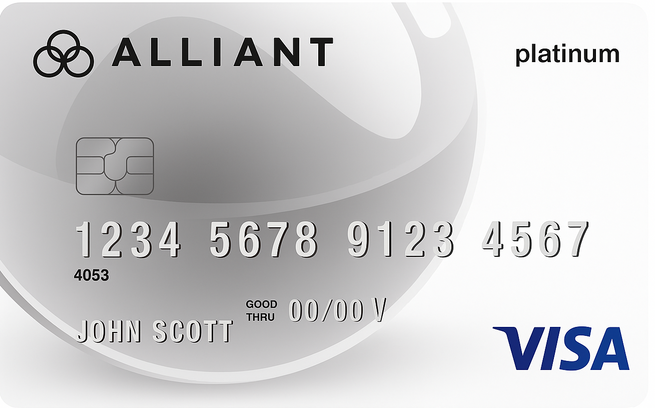If you’re looking for a simple, low-cost credit card option that balances debt consolidation with reliable benefits, our Alliant Visa Platinum card review explains why it’s a solid choice. Its introductory 2% balance transfer fee, affordable long-term APR offer, and lack of an annual fee qualify this card for inclusion in our overview of the best balance transfer cards for average credit scores.
Pros
0% intro APR for 12 months on purchases and balance transfers
Low 2% balance transfer fee
No annual fee
Lower-than-average variable APR after the intro period
Prequalification is available, which won’t impact your credit score
Cons
No significant rewards program
Shorter intro APR period compared to competitors
Alliant Credit Union membership required
About Alliant Visa Platinum
The Alliant Visa Platinum card stands out from competitors because of its focus on keeping borrowing costs low. While it doesn’t try to compete with flashy cash-back bonuses or high-reward rotating categories, it does provide cardholders with a decent intro APR period with the lowest transfer fee rate our research could find in this tier. The card also features a comparatively low standard APR after the promo period ends.
For borrowers already connected to Alliant Credit Union, this Visa Platinum card can be a seamless addition to their existing products and services. It’s particularly helpful for members who want a card that works well for short-term debt reduction without carrying extra costs like an annual fee.
Product InsightsA disclosure form at the Consumer Financial Protection Bureau summarizes the Alliant Visa Platinum details as follows: In summary: The Alliant Visa Platinum card offers an introductory APR of 0% to 5.99% for the first 12 months on purchases and balance transfers, depending on creditworthiness. After that, the APR ranges from 14.49% to 26.49% for the Platinum card and 17.99% to 27.99% for the Platinum Rewards version. Cash advances carry APRs between 22.49% and 28.49%, while a penalty APR of 29.49% may apply if payments are missed or returned. The card has no annual fee, with transaction fees of 2% for foreign purchases, 2% (minimum $5) for balance transfers, and 3% (minimum $10) for cash advances. |
Features and Benefits
While it may not be packed with rewards, the Alliant Visa Platinum still includes practical features and protections that appeal to budget-conscious borrowers.
- 0% intro APR for 12 months on both purchases and balance transfers
- Low 2% balance transfer fee (minimum $5)
- No annual fee
- Competitive variable APR after the intro period
- Auto rental collision damage waiver coverage
- Online account management
- Fraud liability protection
Alliant Visa Platinum Reviews: Editorial Rating
Trusted Company Reviews Rating Score for Alliant Visa Platinum: 8.7
This card earned a strong score because of its affordability, simplicity, and credit union affiliation. While its APR period of 12 months is shorter than some competitors, the low 2% transfer fee and absence of an annual fee make it a solid balance transfer tool. However, its lack of rewards and membership requirements keeps it from ranking higher.
| Intro Offer | Credit Score Needed | Intro Balance Transfer Fee | Annual Fee |
| 0% intro APR for 12 months on purchases and balance transfers | Good (670+) | 2% | $0 |
Why We Like It
We like the Alliant Visa Platinum as a contender for borrowers with average credit primarily because of its low 2% transfer fee intro offer. It’s one of the very few cards available that combines a 0% intro APR with a transfer fee below 3%, which is particularly rare in the average credit score tier category.
What We Don’t Like
Despite the fact that this card ranks well in this tier, it has a few limitations to consider. Once the 12-month intro offer expires, the card offers few perks besides its low average APR and association with a well-liked credit union.
Alliant Visa Platinum Rates, Fees, and Information
As a contender in the balance transfer category, this card’s strongest feature is its cost-efficiency related to its sub-3% transfer fee. However, the card also features a lack of an annual fee, decent approval odds for average-credit consumers, and a relatively low variable APR after the intro period.
The typical APR range for the Alliant Visa Platinum is subject to change, but currently stands at between 14.49% to 26.49%. A rewards version of the card is also available, which carries slightly higher average rates.
Alliant Visa Platinum Card Customer Reviews
Cardholding Alliant Credit Union members cite the card’s low-fees and interest rates as the reason they give for the mostly positive company reviews. The auto rental collision damage waiver, which adds peace of mind, also appears as a positive in many reviews. Negative feedback mostly revolves around the lack of rewards, with some users wishing for more long-term benefits.
Alliant Visa Platinum Vs Citi Double Cash
The Alliant Visa Platinum card and the Citi Double Cash card serve different types of credit card users. In a balance transfer situation, Alliant is better if you’re looking to minimize upfront fees and don’t require an extensive intro APR period.
On the other hand, while the Citi Double Cash card’s transfer fee is higher, it provides a longer 0% intro period for transfers and rewards ongoing spending with a respectable 2% cash back rewards plan. Both appear in our overview of the best balance transfer cards for average credit.
| Alliant Visa Platinum | Citi Double Cash | |
| Intro Offer | 0% intro APR for 12 months on purchases and balance transfers | 0% intro APR for 18 months on balance transfers |
| Ongoing Rewards | No rewards program | Unlimited 2% cash back on all purchases |
| Approval Odds for Average Credit | Good | Good |
| Prequalification Available? | Yes | Yes |
Who Is Alliant Visa Platinum Best For?
This card is best suited for individuals who prioritize simplicity and low future costs over pursuing categorical rewards. If you’re already an Alliant Credit Union member, it’s an easy choice. It works particularly well for people who only need a short, year-long window to pay down balances or enjoy interest-free purchases, followed by long-term value.
How to Get the Most From Using Alliant Visa Platinum
To maximize the benefits this card offers, take advantage of the low 2% balance transfer fee by consolidating balances early in your membership. Or, use the 0% intro APR period for 12 months on purchases to finance necessary expenses, and plan repayment before the promo expires.
Alliant Visa Platinum Alternatives
Alliant Visa Platinum is designed to provide low cost and practical protections, but if you’re searching for cards with more robust rewards or longer intro periods, these alternatives, found in our overview of the best balance transfer cards for average credit, are worth a look.
- Discover it Cash Back: Competitive 15-month, 0% intro APR plus rotating 5% categories and a Cashback Match.
- BankAmericard: 18-month, 0% APR timeframe for both transfers and purchases.
- Citi Double Cash: Long intro period plus a flat 2% return on purchases
- Citi Simplicity: 21-month, 0% APR balance transfer offer plus 12-month, 0% APR on purchases
Frequently Asked Questions
Does the Alliant Visa Platinum card have rewards?
How long is the Alliant Visa Platinum’s intro APR offer?
Do I need to be a member of Alliant Credit Union to apply?
Conclusion
The Alliant Visa Platinum won’t appeal to everyone, but its value lies in simplicity and overall affordability. With a short but useful 0% intro APR period, a low balance transfer fee, and no annual fee, it’s an excellent fit for those who want a straightforward balance transfer solution without extra costs.
Its lack of rewards means that most of its long-term value relies on the likelihood that you’ll qualify for its lower-than-average APR. However, it still has potential as a short-term financial tool to help reduce debt.

Deane Biermeier
Editorial Reviews
Must Reads
Petco Vs PetSmart
Often situated within a reasonable distance from each other, many pet owners wonder which retailer offers the best deals, grooming, training, adoption programs, rewards, pet food brands, and overall services. While both are leaders in the pet retail industry, their...
How Can I Lower My Credit-Card Interest Rate?
Credit cards are powerful financial tools that can help in a number of situations, but they don’t come without risks and costs. One of the most impactful costs is the interest rate, which for credit cards is typically far higher than for personal loans and other...
How to Pay for a Funeral: Costs, Options, Loans, and Plans
Our How to Pay for a Funeral article explores viable options for funding a meaningful service to honor your loved one. According to the National Funeral Directors Association, the average cost of a funeral with a viewing and burial has climbed to over $8,000. There’s...
Can Credit Cards or Personal Loans Help Pay Off Medical Debt?
Recent studies show that Americans currently owe over $220 billion in medical debt. Unfortunately, with the debt typically accruing due to unpredictable medical needs, and Americans already feeling the weight of increased housing, food, utility, and insurance costs,...
Does Debt Consolidation Affect Buying a Home? Here’s What You Need to Know
You may be wondering, “Does debt consolidation affect buying a home?” And you're correct to carefully consider such questions. Buying a home is exciting, and getting your finances in shape first makes the process much easier. Additionally, carrying too much debt when...
How to Budget with Credit Cards Without Going into Debt
Credit cards don’t have to wreck your budget. In fact, when used intentionally, they can make budgeting easier, safer, and even more rewarding. Key Takeaways Credit cards can support a budget by offering real-time tracking, automatic categorization, and strong fraud...
Basepaws Vs Wisdom Panel Pet DNA Testing
Basepaws Vs Wisdom Panel Basepaws Cat DNA testing and Wisdom Panel were both featured on our list of the Best Pet DNA Test Providers. However, each stands apart for varying aspects of its testing and results, making them excellent options for different types of pet...
Wisdom Panel Vs Embark Pet DNA Testing
Wisdom Panel Vs Embark Pet DNA Testing Wisdom Panel DNA Testing and Embark Dog DNA Testing are standout options for testing and learning more about your pet's genetic background and overall health. While both are incredible and affordable options, each stands out in...
How Many Credit Cards Should I Have for Good Credit?
How many credit cards should I have? In short, for most people, two or three cards are ideal to generally provide enough flexibility and maintain a healthy credit profile, without becoming overly complex. Of course, like most things related to personal finance, the...
Are Balance Transfer Cards for Fair Credit Worth It?
Tired of high-interest credit card debt eating away at your budget? And you're hearing that a balance transfer card can provide a way out? Here's the catch—the offers you're hearing about generally only help those with good or excellent credit. If you have fair credit...
